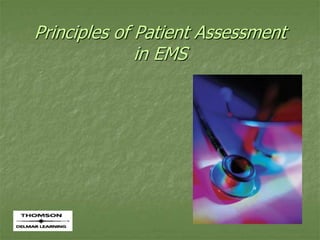
Principles of assessment for ems chapter 07
- 1. Principles of Patient Assessment in EMS
- 2. Chapter 7 – Focused History & Physical Exam Trauma Patient © 2011 Bedford-Parkinson-Tolouei EMT Education Unit
- 3. Objectives Explain how the EMS provider’s assessment of the MOI is critical to the management of the trauma patient. Explain how the EMS provider’s “index of suspicion” relates to the MOI. Describe the two major factors affecting injuries to the body. © 2011 Bedford-Parkinson-Tolouei EMT Education Unit
- 4. Objectives (continued) Describe how the “golden hour” and the “platinum 10 minutes” pertain to the critical trauma patient. Explain why the SAMPLE history is important to the management of the critical trauma patient. © 2011 Bedford-Parkinson-Tolouei EMT Education Unit
- 5. Objectives (continued) Explain why the EMS provider should complete a full assessment on the minor trauma patient who appears to be intoxicated or has an altered mental status. © 2011 Bedford-Parkinson-Tolouei EMT Education Unit
- 6. Introduction In U.S. trauma is the leading cause of death (ages 1 to 44) Many MOI have predictable patterns Evaluation of MOI is essential. Top MOIs: Motor vehicle crashes Falls Poisoning Burns Drownings © 2011 Bedford-Parkinson-Tolouei EMT Education Unit
- 7. Reconsider MOI Early evaluation of the MOI should guide the EMS provider to suspect certain injury patterns “Index of suspicion” – injury patterns help the EMS provider anticipate the potential for shock or other problems © 2011 Bedford-Parkinson-Tolouei EMT Education Unit
- 8. Reconsider MOI (continued) 2 major factors for injuries are: The amount of energy exchanged with the body The anatomical structures involved Inappropriate identification of MOI may result in incorrect treatment and high mortality rates © 2011 Bedford-Parkinson-Tolouei EMT Education Unit
- 9. Reconsider MOI (continued) “Index of suspicion” for a spinal injury: Cracked windshield Bent steering wheel Dented dashboard Side door intrusion into motor vehicle © 2011 Bedford-Parkinson-Tolouei EMT Education Unit
- 10. Evaluating the MOI The presence of a significant MOI is a key decision point in the assessment algorithm This key decision point can make a significant impact on the life or death of a critical trauma patient © 2011 Bedford-Parkinson-Tolouei EMT Education Unit
- 11. Evaluating the MOI (continued) Key decisions regarding the MOI should help the EMS provider: Minimize scene time Quickly perform a rapid trauma assessment Perform life-saving procedures Transport to the appropriate facility © 2011 Bedford-Parkinson-Tolouei EMT Education Unit
- 12. Evaluating the MOI (continued) Consider the following questions: How long ago did this happen? How fast or what velocity was involved? How hard was the impact or surface impacted upon? How high did the patient fall from? How far did the patient travel before stopping? © 2011 Bedford-Parkinson-Tolouei EMT Education Unit
- 13. Evaluating the MOI (continued) Distracting injuries can keep more serious injuries from being discovered quickly Scene management can also cause delays: Multiple patients Relatives Bystanders Other rescuers Minor trauma can appear serious at first © 2011 Bedford-Parkinson-Tolouei EMT Education Unit
- 14. Significant Trauma Detailed observation is key to managing the patient with significant trauma Don’t be distracted by less serious injuries © 2011 Bedford-Parkinson-Tolouei EMT Education Unit
- 15. Golden Hour Time is a critical factor for the patient with a significant MOI Barring the need for extrication, the rule of the “Golden hour” and the “Platinum 10 minutes” will apply © 2011 Bedford-Parkinson-Tolouei EMT Education Unit
- 16. Platinum Ten Minutes The maximum time EMS providers stay on the scene for a critical trauma patient © 2011 Bedford-Parkinson-Tolouei EMT Education Unit
- 17. Rapid Trauma Assessment (RTA) Quick and systematic exam of these body sections: Head Chest Abdomen Pelvis Extremities Back/buttocks © 2011 Bedford-Parkinson-Tolouei EMT Education Unit
- 18. Rapid Trauma Assessment (RTA) After the RTA obtain baseline VS and a SAMPLE history When the patient is unresponsive obtain the information from bystanders, relatives, or other first responders Do not extend the scene time to obtain info © 2011 Bedford-Parkinson-Tolouei EMT Education Unit
- 19. Rapid Trauma Assessment (RTA) Perform a detailed physical exam enroute Transportation destination depends on the needs of the patient and capabilities of a trauma center as well as your local protocols © 2011 Bedford-Parkinson-Tolouei EMT Education Unit
- 20. Rapid Trauma Assessment (RTA) All your efforts on the scene and enroute may be for naught when a critical trauma patient is transported to an inappropriate facility © 2011 Bedford-Parkinson-Tolouei EMT Education Unit
- 21. Ongoing Assessment (OA) Repeat IA, reassess VS, and interventions Repeat OA every 5 minutes on critical trauma patients In cases of short manpower or short transport time – performing the OA takes priority over the DPE © 2011 Bedford-Parkinson-Tolouei EMT Education Unit
- 22. Minor Trauma Examples: Isolated extremity injury Minor burns Small lacerations or abrasions An exception would be a minor injury with an altered mental status or intoxication © 2011 Bedford-Parkinson-Tolouei EMT Education Unit
- 23. Focused Physical Exam: Assess D – deformity C – contusions A – abrasions P – punctures/penetrations B – burns T – tenderness L – lacerations S – swelling © 2011 Bedford-Parkinson-Tolouei EMT Education Unit
- 24. Focused Physical Exam: Assess Range of motion (ROM) Pulse, motor, and sensation (PMS) Skin color, temp. and condition (CTC) © 2011 Bedford-Parkinson-Tolouei EMT Education Unit
- 25. Additional Steps in Minor Trauma Patient Assessment Develop a treatment plan Perform interventions(s) Obtain baseline VS Obtain SAMPLE history Perform OA every 15 minutes © 2011 Bedford-Parkinson-Tolouei EMT Education Unit
- 26. Conclusion EMS providers can make a significant impact on the life or death of a critical trauma patient by: Minimizing scene time Performing a RTA Performing life-saving interventions Transporting to an appropriate facility © 2011 Bedford-Parkinson-Tolouei EMT Education Unit
- 27. Conclusion The decision point as to the presence of a significant MOI will predicate the extent of exam, speed, priority of transport, and destination © 2011 Bedford-Parkinson-Tolouei EMT Education Unit
